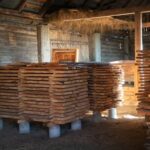Rust is a common enemy for woodworking machines. Left untreated, it can cause serious damage and compromise the performance of these valuable tools. This article will guide you through the process of removing rust from woodworking machines, ensuring that they maintain their longevity and functionality.
Woodworking machines are constantly exposed to moisture and various environmental factors that make them prone to rust formation. Rust not only affects the appearance of the machines but also hinders their smooth operation. It can lead to sticky mechanisms, jammed parts, and even structural weakness if left unchecked. Regular maintenance and rust prevention are crucial in preserving the quality and efficiency of woodworking machines.
Identifying rust on woodworking machines is a vital step in addressing this issue promptly. Signs such as discoloration, flaking paint, rough surfaces, or corrosive residue indicate the presence of rust. Understanding how rust develops on these machines enables us to effectively combat it. Moisture, humidity, exposure to water or chemicals, and lack of proper storage are some common causes of rust formation in woodworking machines.
In order to remove rust from your woodworking machines effectively, you’ll need the right tools and materials at hand. Safety equipment such as gloves, goggles, and masks should be worn when working with rusted surfaces. Wire brushes, sandpaper, chemical rust removers, lubricants, and cleaning solutions are among the essential tools needed for the rust removal process. Proper preparation of the machine before starting is also important to ensure maximum efficiency during the removal process.
By understanding why removing rust is important and having a clear idea of how to identify it on your woodworking machinery, you can take proactive steps towards maintaining their optimal performance. In the following sections of this article, we will delve into specific techniques for removing rust from different components of woodworking machinery and explore preventive measures for keeping them free from future corrosion issues.
Identifying Rust on Woodworking Machines
Rust can be a common and frustrating issue for woodworking machine owners. It not only affects the appearance of the machines but also compromises their performance and longevity. In this section, we will explore how to identify rust on woodworking machines by discussing the signs and causes of rust formation.
Signs of Rust:
- Discoloration: One of the most obvious signs of rust is the appearance of reddish or orange-brown stains on the surface of the machine.
- Rough Texture: When rust develops, it can create a rough texture on the affected areas, making it difficult for machinery parts to move smoothly.
- Corrosion: As rust progresses, it can lead to corrosion, causing damage to critical components and affecting overall functionality.
- Weakness or Friction: Rust buildup can weaken machine parts and create friction, resulting in decreased performance and potential safety hazards.
Causes of Rust Formation:
- Moisture Exposure: Woodworking machines are particularly vulnerable to moisture, as wood naturally contains a certain level of moisture content that can contribute to rust formation.
- Humidity in Workspaces: High humidity environments increase the likelihood of condensation forming on the surfaces of machines, leading to moisture retention and rust development.
- Lack of Lubrication: Insufficient lubrication allows moisture and other contaminants to settle on machine surfaces, promoting rust growth over time.
- Improper Storage: Machines stored in damp or unventilated areas without proper protection are more susceptible to rust due to prolonged exposure to moisture-laden air.
To prevent further damage to woodworking machines, it is crucial to identify rust early on and take immediate action. Regular inspection and maintenance routines are essential for detecting early signs of rust formation and implementing appropriate prevention measures. By being proactive in identifying and addressing rust issues, woodworkers can ensure their machines continue performing at their best for years to come.
Essential Tools and Materials for Rust Removal
Removing rust from woodworking machines requires the use of specific tools and materials to effectively eliminate corrosion and restore the machine’s performance. Here are some essential tools and materials you will need:
- Protective Equipment: Before starting the rust removal process, ensure your safety by wearing appropriate protective equipment such as goggles, gloves, and a dust mask. This is important to protect yourself from any harmful chemicals or debris that may be produced during the cleaning process.
- Rust Removers: There are various types of rust removers available in the market such as commercial rust converters, phosphoric acid-based solutions, vinegar, or lemon juice. Choose a rust remover that is suitable for your woodworking machine and follow the manufacturer’s instructions for proper application.
- Scrub Brushes: To physically remove rust from the surface of your woodworking machine, you will need different types of scrub brushes. Wire brushes with stiff bristles are ideal for heavy-duty cleaning on metal surfaces. Additionally, nylon bristle brushes can be used for more delicate areas.
- Sanding Tools: Sanding is another effective method for removing surface rust. You will need various grits of sandpaper or abrasive pads depending on the severity of the rust. Coarse grits can be used initially to remove thick layers of rust, while finer grits are used for smoothening out the surface.
- Rust Inhibitors and Protective Coatings: After removing the rust from your woodworking machine, it is crucial to apply a rust inhibitor or protective coating to prevent future corrosion. Anti-rust sprays or coatings create a barrier between moisture and metal surfaces, reducing the likelihood of rust formation.
Remember to always read and follow the instructions provided by the manufacturers of these tools and materials. It is also recommended to test any rust removers or coatings on a small, inconspicuous area of your woodworking machine before applying them to the entire surface.
Safety should be your top priority when dealing with rust removal, so ensure you are working in a well-ventilated area and take proper precautions to protect yourself from any potential harm. By using the right tools and materials, you can effectively remove rust from your woodworking machines and restore them to their optimal condition.
Preparing Woodworking Machines for Rust Removal
Before starting the rust removal process on woodworking machines, it is essential to properly prepare the machines to ensure safe and effective cleaning. In this section, we will provide a guide on how to prepare your woodworking machines for rust removal, including tips for removing detachable parts and cleaning techniques for specific machine components.
Firstly, it is important to ensure that the machine is completely powered off and unplugged before beginning the preparation process. This will help prevent any accidents or injuries while working with the machinery. Additionally, make sure you have gathered all the necessary tools and materials for rust removal beforehand.
When preparing woodworking machines for rust removal, it is often recommended to remove any detachable parts such as handles, knobs, or protective covers. This will allow you to clean these parts more effectively and reduce the chance of any damage occurring during the rust removal process. It is advisable to keep track of any screws or small components that are removed by organizing them in labeled containers or bags so they can be reassembled correctly later.
Cleaning techniques can vary depending on the specific machine component being treated. For example, when addressing rust on a table saw surface, using a mixture of vinegar and water can be effective. Apply the solution onto the rusty areas and let it sit for some time before scrubbing with a brush or non-abrasive pad. Similarly, blades can be immersed in a vinegar solution or soaked in an appropriate rust remover product.
By properly preparing your woodworking machines before starting the rust removal process, you can ensure that you achieve optimal results while minimizing any potential damage to the machine. Taking care in this initial step will pave the way for successful rust eradication in later stages.
| Necessary Tools | Safety Equipment and Precautions |
|---|---|
| – Screwdrivers (various sizes) | – Gloves |
| – Wrenches | – Safety glasses |
| – Soft-bristle brushes | – Dust mask/respirator |
| – Non-abrasive pads or steel wool | – Ear protection (if using noisy tools) |
Different Rust Removal Methods for Woodworking Machines
Chemical Rust Removers
One effective method for removing rust from woodworking machines is using chemical rust removers. These products contain special chemicals that dissolve or convert the rust, making it easier to remove. Chemical rust removers are available in different forms such as sprays, gels, and liquids. Before applying any chemical rust remover, it is important to ensure that the machine is unplugged and all detachable parts are removed.
To use a chemical rust remover, start by applying the product directly onto the rusty areas of the machine. Follow the manufacturer’s instructions for application time and any necessary agitation. After the specified time has passed, use a wire brush or abrasive pad to scrub away the loose rust.
Rinse the machine thoroughly with water to remove any residue from the chemical rust remover. It is important to wear protective gloves and goggles when using these products and work in a well-ventilated area.
Wire Brushing
Another common method for removing rust from woodworking machines is wire brushing. This method involves using a wire brush or abrasive pad to physically scrub away the rust from the surface of the machine. Wire brushing can be done manually with a handheld brush or using a drill attachment for larger areas.
Before beginning, make sure to wear protective gloves and safety goggles to protect yourself from any flying debris during the process. Start by applying some lubricant or penetrating oil to loosen up the rust. Then, use the wire brush or abrasive pad to scrub away the rust in a back-and-forth motion. Be sure not to apply too much pressure which could damage the surface of the machine.
Sanding
Sanding can also be an effective method for removing stubborn rust from woodworking machines. This method involves using sandpaper or sanding discs with varying grits to gradually sand away layers of rust until a smooth surface is achieved. Sanding can be done by hand or using a power sander for larger areas.
Before sanding, make sure to protect yourself with gloves and safety goggles. Start with a coarse grit sandpaper to remove the bulk of the rust, then gradually move to finer grits to smoothen the surface. Remember to keep the sandpaper or sanding discs clean by frequently tapping them against a hard surface or using a cleaning stick, as clogged abrasives will be less effective.
It is important to note that regardless of the rust removal method chosen, always take proper safety precautions and follow manufacturer’s guidelines for any products used. Some methods may require multiple applications or additional steps depending on the severity of the rust. Removing rust from woodworking machines can be time-consuming, but it is essential for maintaining their performance and prolonging their lifespan.
Rust Removal for Specific Woodworking Machine Components
When it comes to removing rust from woodworking machines, it is essential to address each specific machine component individually. Different parts of the machines have different challenges and require unique techniques for effective rust removal. In this section, we will go over the steps and techniques for removing rust from specific woodworking machine components such as the table saw surface, blades, fence, and motor.
1. Table Saw Surface:
The table saw surface is often subjected to a lot of wear and tear, making it prone to rust formation. To remove rust from the table saw surface, start by thoroughly cleaning the surface with a mild detergent and water. Then, use a wire brush or sandpaper to gently scrub away the rusted areas.
Be careful not to damage the surface while removing the rust. Once you have removed the rust, apply a coat of protective wax or spray to prevent future oxidation.
2. Blades:
Rusted blades can severely hinder the performance and accuracy of your woodworking projects. To remove rust from blades, start by detaching them from the machine. Clean any debris on the blades using a stiff brush or compressed air. If there are stubborn rust spots, you can use fine-grit sandpaper or steel wool to gently remove them. Make sure to follow the manufacturer’s instructions when handling blades and always wear gloves for safety purposes.
3. Fence:
The fence is another critical component that needs attention when dealing with rusty woodworking machines. Start by loosening any screws or bolts attaching the fence to the machine. Once detached, inspect for any signs of corrosion or rusting on both sides of the fence.
Use a wire brush or steel wool dipped in a rust remover solution to scrub away any visible rust spots. After completing this process, rinse off any residue with clean water and dry thoroughly before reattaching it to your machine.
4. Motor:
The motor is one of the most vital parts of a woodworking machine, and rust formation can lead to irreversible damage. Before attempting to remove rust from the motor, make sure to disconnect the power source or unplug the machine completely. Use a damp cloth or sponge with a mild cleaning solution to wipe away any dirt or debris on the motor’s surface.
For removing rust, avoid using abrasive materials that may damage the delicate parts of the motor. Instead, opt for sandpaper or wire brushes specifically designed for use on motors.
| Woodworking Machine Component | Rust Removal Techniques |
|---|---|
| Table Saw Surface | – Clean surface with mild detergent and water
|
| Blades | – Detach blades from machine
|
| Fence | – Loosen screws/bolts attaching fence
|
| Motor | – Disconnect power source/unplug machine
|
Preventive Measures and Rust Protection for Woodworking Machines
Woodworking machines are a valuable investment, and it is crucial to protect them from rust. Rust not only affects the appearance of the machines but can also lead to performance issues and damage over time. To keep your woodworking machines in top shape, it is essential to implement preventive measures and rust protection strategies.
One effective way to prevent rust formation on woodworking machines is by controlling the humidity in your workshop. High levels of moisture in the air can accelerate the oxidation process, leading to rust. It is recommended to maintain a relative humidity level of around 40-50% in your workshop. This can be achieved by using dehumidifiers or ensuring proper ventilation.
Additionally, proper storage plays a vital role in preventing rust on woodworking machines. When not in use, make sure to cover your machines with breathable materials such as canvas or cloth covers to protect them from dust and moisture. Avoid storing them directly on concrete floors, as concrete retains moisture that can seep into the machines.
Using rust inhibitors and protective coatings can provide an extra layer of defense against rust formation. Before applying any coating or inhibitor, ensure that the surface of the machine is clean and free from any existing rust. Apply the product as directed by the manufacturer, focusing on areas prone to rusting.
Regular maintenance and inspection are essential for preventing rust buildup on woodworking machines. Routinely check for any signs of corrosion or rust spots during your inspections. If you notice any early signs of rust formation, take immediate action to remove it following the appropriate methods discussed earlier in this article.
By implementing these preventive measures and adopting a proactive approach towards rust protection, you can significantly extend the lifespan of your woodworking machines and maintain their optimal performance.
Maintenance and Regular Inspection
Regular maintenance and inspection are crucial for keeping woodworking machines in optimal condition and preventing rust buildup. By incorporating these tasks into a routine schedule, woodworkers can ensure the longevity and performance of their equipment. This section will emphasize the importance of maintenance and provide practical tips for inspecting and caring for woodworking machines.
Performing Routine Inspections
Regular inspections allow woodworkers to identify any signs of rust or other issues before they become major problems. It is recommended to inspect woodworking machines at least once a month or after prolonged periods of non-use. During the inspection, pay close attention to areas prone to rust, such as exposed metal surfaces, joints, and hinges.
Check for any visible signs of rust, including discoloration or bubbling on the surface of the metal components. Additionally, look out for flaking paint or dull patches that may indicate underlying rust formation. Use a flashlight if necessary to examine hard-to-reach areas.
Maintenance Tasks
In addition to regular inspections, there are several maintenance tasks that should be performed to keep woodworking machines free from rust:
- Cleaning: Regularly clean the machines with a soft dry cloth or brush to remove dust, debris, and sawdust accumulation. Pay special attention to crevices and corners where moisture can collect.
- Lubrication: Apply appropriate lubricants to moving parts such as bearings, pulleys, gears, and slides to prevent friction and minimize wear. Be sure to use lubricants specifically formulated for woodworking machinery.
- Rust Prevention: Consider applying a rust inhibitor or protective coating on metal surfaces susceptible to corrosion. This extra layer of protection can help repel moisture and prevent rust formation.
- Belt Tension: Check and adjust the tension of belts regularly. Loose belts can cause vibrations that lead to increased wear on machine components.
- Blade Maintenance: Inspect blades regularly for signs of rust or damage. Clean and sharpen blades as needed to maintain cutting precision.
Make a checklist of these maintenance tasks and set a reminder in your calendar to ensure they are consistently performed.
Frequency of Maintenance
The frequency of maintenance tasks may vary depending on the frequency of machine use and the specific conditions of the workshop environment. However, it is generally recommended to perform routine maintenance at least every three months, with more frequent inspections for heavily used machines or in moist environments.
By establishing a regular maintenance schedule and sticking to it, woodworkers can proactively address rust issues and extend the lifespan of their woodworking machines. Following proper inspection procedures and carrying out necessary maintenance tasks will help keep these machines in optimal condition for years to come.
Conclusion
In conclusion, removing rust from woodworking machines is crucial for restoring and preserving their performance. Rust can have detrimental effects on these machines, causing them to become less efficient and eventually break down. By regularly maintaining and preventing rust, woodworkers can ensure the longevity of their equipment.
Throughout this article, we have discussed the importance of identifying rust on woodworking machines and understanding its causes. This knowledge allows woodworkers to take immediate action when rust appears, preventing further damage. We have also provided a comprehensive list of essential tools and materials needed for rust removal, along with safety precautions to keep in mind while working with rusted machines.
Furthermore, we have explored different methods for removing rust from woodworking machines, including chemical removers, wire brushing, and sanding. Each method has its own pros and cons, but all are effective in eliminating rust. Additionally, we have provided detailed instructions and techniques for removing rust from specific machine components such as table saw surfaces, blades, fences, and motors.
To prevent future rust formation, it is important to implement preventive measures such as proper storage and humidity control in the workshop. Using rust inhibitors and protective coatings can also significantly extend the lifespan of woodworking machines. Lastly, regular maintenance tasks should be performed to keep these machines free from rust buildup.
Frequently Asked Questions
How do you remove rust from machines?
Removing rust from machines typically involves a series of steps to effectively restore the surface of the machine. First, it is important to ensure safety by wearing protective gloves and goggles. Begin by using a wire brush or sandpaper to gently scrub away loose rust particles from the machine’s surface. Then, apply a rust dissolver or converter specifically designed for metal surfaces to neutralize any remaining rust.
Follow the product instructions carefully, allowing enough time for the solution to penetrate and react with the rust. Afterward, thoroughly rinse the machine with water and dry it completely. To prevent future rusting, consider applying a protective coating such as paint or a rust inhibitor.
How do you remove rust from workshop tools?
When it comes to removing rust from workshop tools, it is crucial to start by inspecting each tool individually for any signs of damage or excessive corrosion. If the tool is severely damaged, it may be necessary to consider replacing it instead of attempting to remove the rust. For less severe cases of rust, begin by spraying or soaking the affected areas with a suitable penetrating oil like WD-40 or vinegar.
Let it sit for some time to loosen up the rust, then use steel wool or sandpaper to gently scrub away the loosened particles. Repeat this process as needed until all visible rust is removed. Finally, make sure to thoroughly clean and dry each tool before storing them in a dry environment.
How do you remove rust from machined parts?
Removing rust from machined parts requires careful attention and precision since these parts often have complex shapes and sensitive surfaces that can be easily damaged during the process. Start by cleaning the machined parts with a mild detergent and warm water solution to remove any dirt or debris that may have gathered on them. Next, use fine-grit sandpaper or an abrasive pad to carefully remove superficial rust layers by hand without causing any scratching or gauging on the part’s surface finish.
If necessary, apply a commercial rust remover following its instructions strictly while avoiding extended exposure or overuse. Once the rust is removed, rinse the part thoroughly and allow it to dry completely before considering any further treatments or coatings to prevent future corrosion.

Hi everyone! I’m a woodworker and blogger, and this is my woodworking blog. In my blog, I share tips and tricks for woodworkers of all skill levels, as well as project ideas that you can try yourself.





